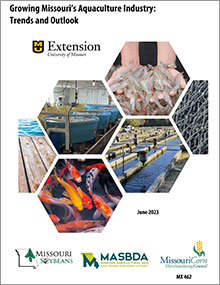Editor’s note
The following abstract describes a publication that is only available as a downloadable PDF.
Overview

This report summarizes aquaculture in Missouri, the U.S. and the world. It highlights aquaculture production and consumption, summarizes U.S. and global aquaculture industry trends and offers further detail about channel catfish and rainbow trout — the major fish species grown by Missouri aquaculture producers. Special attention focuses on aquaculture’s use of plant-based feeds.
Aquaculture is defined in the National Aquaculture Act of 1980 as “the propagation and rearing of aquatic species in controlled or selected environments.” Ponds and lakes are the most common aquaculture environments in the inland U.S. Other production systems include raceways, recirculating systems, non-recirculating systems and aquaponics. In addition to food fish production, aquaculture is important for producing sportfish, ornamental fish and aquatic species for conservation purposes.
Globally, food fish provide an important source of protein and nutrition. Aquaculture can play a key role in meeting growing food demand from an increasing global population while using resources efficiently. Aquaculture systems help to manage and conserve the world’s natural fisheries. It also helps supply higher-value seafood products demanded by consumers in developed economies, including the U.S.
Producer groups have long invested in aquaculture initiatives. Domestic soybean industry investment helped increase U.S. soy protein demand from global aquaculture producers, especially those in Asia. Similar corn industry initiatives resulted in greater aquaculture feed demand for dried distillers grains with solubles (DDGs). From both supply and demand sides, U.S. crop producers have compelling reasons to support U.S. aquaculture. Furthermore, aquaculture enterprises may add viable income streams to existing farms and other businesses in Missouri and the Midwest, especially where it is feasible to include regionally produced grains and oilseeds in aquaculture feed.
Contents
- Overview
- Aquaculture in Missouri
- Aquaculture Value of Production
- Aquaculture Production Value by Sector
- Aquaculture Producers
- Missouri Aquaculture Production Area and Practices
- Comparing Aquaculture in Missouri, Other Midwestern States and Arkansas
- Aquaculture in the U.S.
- Volume and Value of U.S. Aquaculture
- Major U.S. Aquaculture Production Areas
- Production Cycles and Supply Chains for Major Freshwater Species
- Catfish
- Trout
- Other Species: Hybrid Striped Bass, Yellow Perch and Tilapia
- U.S. Aquaculture Industry Growth
- U.S. Seafood Imports
- Global Aquaculture
- Global Aquaculture Production
- Global Aquaculture Consumption and Demand
- Global Aquaculture Trends
- Aquaculture Feed
- Trends in Aquaculture Feed
- Alternative Protein Ingredients
- Soybean Use and Potential by U.S. Aquaculture
- Distillers Products Use and Potential by U.S. Aquaculture
- Additional Plant-Based Ingredients
- Animal By-Product Meals and Potential Use in Aquaculture Feeds
- Novel Protein Ingredients
- Alternative Lipid Sources
- Aquaculture Feeds in Missouri
- Atypical Ingredients Needed
- Expertise Needed
- Conclusion
- References
- Appendix: Dietary Formulation Examples for Aquatic Animals
Pages
- 43